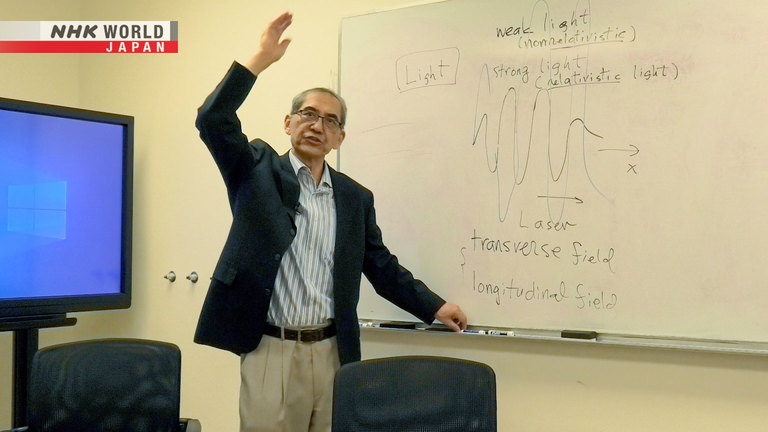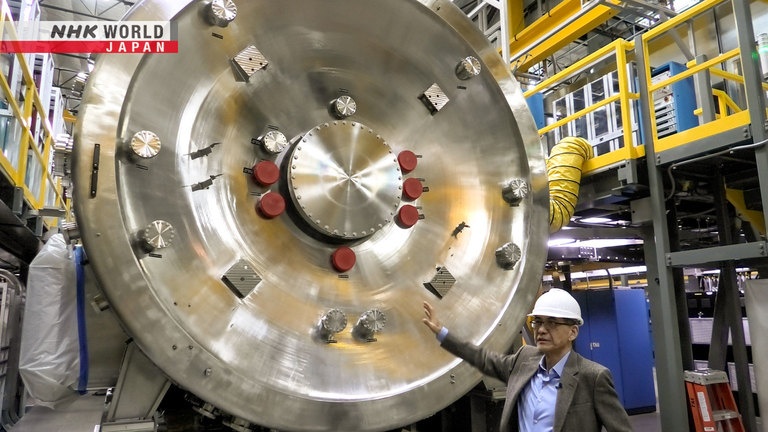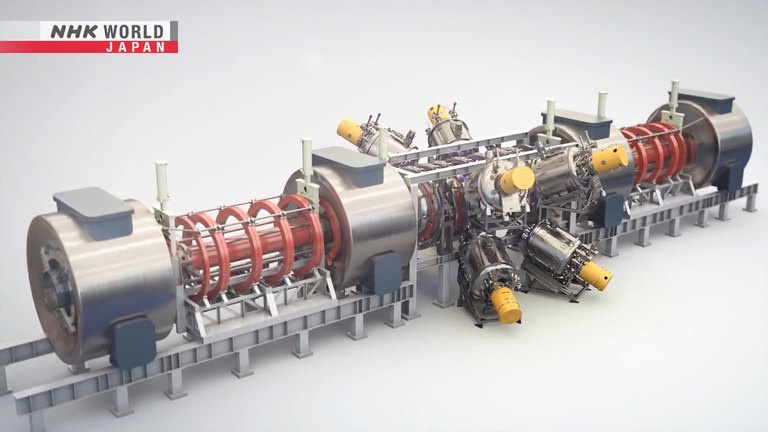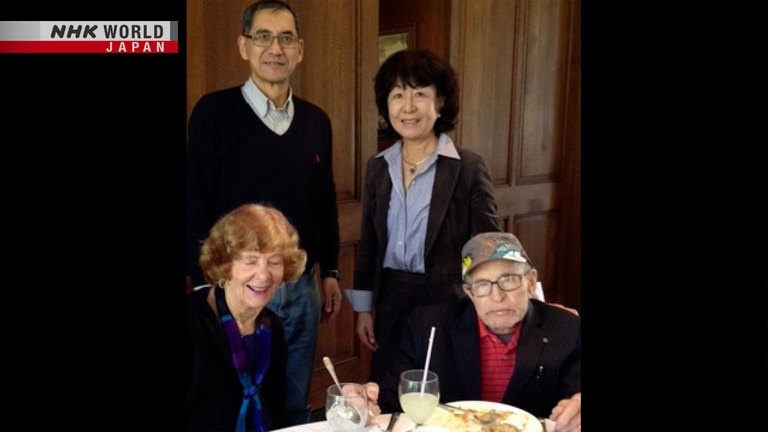Special Episode: Dual-wielder Scientist Challenges Nuclear Fusion
Amid growing concerns about global warming, nuclear fusion is once again in the spotlight as an emissions-free energy source. The development of fusion reactors is now within our reach. One of the key persons in this field is Toshiki Tajima, who resides in the United States. The venture company where Tajima works as Chief Science Officer (CSO) is attracting attention from all over the world. Tajima is not an engineer, but a physicist world famous for his discovery of "laser wakefield acceleration" (LWFA). His paper published in 1979 is one of the most cited articles in plasma physics. Professor Tajima is 75 years old now, and he is still at the frontline of theoretical physics. In this episode, we will see two different facets of his research: in academia and in a venture business.




Transcript
The sun makes our planet habitable, and nurtures life on Earth.
Its energy is generated through nuclear fusion.
If human beings find a way to reproduce nuclear fusion on Earth, we will get limitless energy without depending on fossil fuels,
which have now cornered us to the brink of catastrophe.
We have been dreaming of nuclear fusion technology, another sun on the Earth.
Now, more than 25 venture companies all over the world are intensively competing to develop fusion reactors.
Among them, TAE Technologies in California is one of the biggest.
So far, it has raised over 1.2 billion dollars, from Goldman Sachs, Google, Sumitomo Corporation of Americas, and so on.
The Chief Science Officer of TAE is Toshiki Tajima, a Japanese researcher.
This is the Flag Room, as we call sometimes.
Flags, you can see, this is the American flag over there, British flag, French flag...
And if you look at here, you have also Japanese flag, Canadian flag, Israeli flag, German flag, Korean, etc.
I don't know how many, 30 or so flags, that means that there are at least 30 or so nationalities of citizens who work at TAE.
We collect the best scientists not only in the US but around the world.
The experimental device "Norman" has a cylindrical shape, 27 meters long and 9 meters high.
And in the center, it has eight yellow-colored accelerators.
Cylinder of "Norman" plasma here.
You see the horizontal structure a little bit from the upper side of the cylinder.
Yellow tanks are the accelerators.
There are eight, you can see only two from this side.
Two from the bottom side, and the other side has another four.
We try to make a ring of beams inside Norman plasma, like this, to make the plasma stable and energetic.
In 2011, Tajima joined this venture company as one of its directors, and since then he has been working on development of a fusion reactor.
Originally, Tajima was not an entrepreneur, but a pure academic researcher.
He is 75 years old, and still teaches theoretical physics at the University of California, Irvine.
Professor Tajima has been working at the front line of plasma physics for decades, and his name is quite well known in the academic world.
Now that global warming is one of our biggest concerns, more than a small number of Tajima's students are interested in nuclear fusion as a carbon-free energy.
I want to introduce my students.
One of them is away to Japan right now.
Honestly, I think the chance to be able to contribute to something world-changing as achieving fusion energy, and any amount I can contribute to that, I think that's just really fascinating, and really honorable.
Plus, there's a big fusion reactor that you can look at in the sky everyday, for inspiration.
Well, if the sun can do it, so we can do it, right?
This four-page paper, "Laser Electron Accelerator" in 1979 made Toshiki Tajima known to the world.
It is said to be one of the most cited articles in plasma physics.
Tajima discovered a phenomenon and named it "Laser Wakefield Acceleration."
It looks similar to the wake of a boat on the water.
He predicted an intense laser pulse would create electro-magnetic waves behind it, which could be compared to a boat and its wake.
Plasma is a state of matter so energetic that electrons and nuclei separate from each other.
When we shoot a laser pulse into a plasma, the pulse creates a wake behind it, which catches electrons and accelerates them to near to the speed of light.
Tajima's theory suggested that this phenomenon could be applied to creating much smaller particle accelerators than existed at that time.
When Tajima published this thesis, he was a 31-year-old, post-doctoral fellow, just four years after he got a PhD degree.
The inspiration came to him from a totally unexpected place.
It was Shinobazu Pond in Ueno, Tokyo, which he used to pass by every day in his undergraduate years.
This is a duck moving to the right, and behind it you see the wakefield is generated behind the duck.
And the baby ducks are very smart, they try to save their energy.
So they ride on the wake which the mother duck creates.
If you ride on the wave, you can go without too much energy, right?
That's what the duck's babies do, based on the mother duck's wakefield behind it.
So, the baby ducks are particles?
Particles, exactly! They can get accelerated by the mother duck's force.
I saw this phenomenon every day when I commuted between Ueno Station and the University of Tokyo campus, by watching Shinobazu Pond, such a phenomenon.
The discovery was highly acclaimed all over the world, and Tajima started a prominent career as a theoretical physicist.
But now, he is also working at a venture company taking on the challenge of developing a nuclear fusion reactor.
What led him to become such a two-way player: academics and a venture business?
In this episode, we will see the frontline of nuclear fusion and laser physics with Toshiki Tajima.
In 1973, Toshiki Tajima earned a Master's degree at the University of Tokyo.
He went to the United States to study plasma physics, a branch of scientific research which had just started.
He was 25 years old.
He chose a brand-new university― the University of California, Irvine.
The campus had been founded just eight years earlier.
His reason was that UCI had Norman Rostoker, a renowned Canadian physicist.
He was one of the founding fathers of plasma physics.
Rostoker changed Tajima's destiny.
Surprisingly, the great physicist came
to meet me at the airport.
But he was wearing a Hawaiian shirt, and without shoes.
Just worn-out sandals.
At first, I thought he was a gangster.
But he was world-famous Norman Rostoker.
Quite casual, and warm-hearted.
How could he come to meet a no-one like me at the airport?
I was so shocked.
Unbelievable.
I felt so grateful, so happy.
At that time, the Rostoker lab had two research subjects.
One was to find a path to developing a nuclear fusion reactor, which would solve energy shortage issues in the world.
And the other was to discover a new approach to accelerate particles, including compactification.
These two themes were separate, but the lab members actively and freely discussed their topics with each other.
These billiard balls in Tajima's office are the memory of the atmosphere.
After the lab work, we usually went to a bar,
had dinner, and then played pool.
At the pool table, we chatted a lot,
"How is your experiment going today?"
Drinking, pool, and a lot of casual discussion until midnight.
That was our routine.
These billiard balls remind him of the free atmosphere, where professors and students mingled and carried on cross-topic discussions regardless of their current duties.
This may have been the origin of Tajima as a two-way player; both plasma physics and fusion, and both academia and business.
By the way, the second theme of the Rostoker lab, making accelerators compact, has been realized through Tajima's laser wakefield acceleration.
In 2004, a tiny accelerator that fits on the palm was created.
The nuclear fusion venture where Tajima works as Chief Science Officer was founded by Rostoker in 1998.
Look at this one.
This is the first machine that Norman started on the campus of UCI.
He used a sewage pipe as the first reactor model, the first model of TAE.
Late 90s.
So, this is the earliest machine of TAE, which was sitting in the campus parking lot at that time.
In 2011, in his latter days, Rostoker asked Tajima to join TAE Technologies to help him develop a nuclear reactor.
At that time, Tajima was working at a university in Munich, Germany.
He finally decided to go back to California and work for his lifetime mentor.
The guy next to him is Michl Binderbauer, the CEO of TAE Technologies.
Binderbauer, who is originally from Salzburg, Austria, was also a student of Rostoker.
He joined TAE from the outset, and has been leading its research and development for 25 years.
TAE's approach to a nuclear fusion reactor is unique.
Most nuclear fusion reactors use the deuterium-tritium or D-T reaction.
Deuterium and tritium, both heavier isotopes of hydrogen, release a huge amount of energy when their nuclei fuse together.
The reaction produces a helium nucleus and a neutron.
However, the neutrons are potentially dangerous, which is a major obstacle for fusion reactors.
But TAE challenges what is called the proton-boron or p-B11 reaction.
If we fuse a boron nucleus with a proton, the output will be three helium nuclei plus energy, without any neutrons.
However, it takes temperatures 30 times higher than D-T, and so it is thought to be far more challenging.
Once you get neutrons involved, you get radioactivity as a byproduct, radio activation of the equipment you use, and all sorts of headaches.
Not even the least to speak about, that tritium isn't a naturally occurring product.
You have to breed it.
Boron doesn't suffer these things.
TAE pursues the proton-boron reaction because Tajima and Binderbauer inherit Rostoker's philosophy: "End in Mind."
That is, in research and development, we must never forget what the goal is, and have to design our strategy backwards from the goal.
At national institutes, research goes step by step.
At the end of a five-year plan,
we submit a report on the progress we have made.
And if it is accepted, then we will have another budget.
That's how they work.
Prof. Rostoker always said, "End in Mind."
"Think from the goal, then do what you need to do."
It is a totally different direction.
TAE has its own theory to succeed with proton-boron, which is much more difficult.
The TAE plasma fusion device shoots heated hydrogen from outside the cylinder, and lets it form a spine in the middle to create a plasma.
And beams from the eight accelerators in the center rotate the plasma to make it stable.
TAE's theory is: If it is difficult to get temperatures 30 times higher, then use accelerators to put more energy into the plasma.
So to me, it became a holistic calling now in my life, to not only for the sake of creating cool technology and making a difference economically,
but to really try to attack one of the most existential problems of our time, which is climate change.
If we choose D-T, neutrons are unavoidable.
So it is not so safe. That's the simple answer.
But many researchers leave our goal out of their minds.
They just shelve the problem.
The ultimate goal of nuclear fusion is a reactor
that generates power and creates energy for us.
Both Tajima and Binderbauer firmly believe that proton-boron is the only feasible choice to create energy for human beings.
Rostoker's "End in Mind" spirit is still alive.
To expedite development, TAE has launched a joint research project in Japan, where Tajima was born.
The National Institute for Fusion Science, or NIFS, in Toki, Gifu Prefecture has one of the biggest nuclear fusion experiment facilities in the world.
In February 2022, the experiments with proton-boron fusion reactions started.
Due to COVID, TAE staff joined remotely from California in the middle of the night.
If helium nuclei are detected when boron powder is put into proton beams, it means the proton-boron reaction was successfully made.
Boron was put in at the fourth second, right?
Something seems to be happening.
It might be possible.
The gradient is apparently different.
But we need to analyze further
if it is helium, or any other things happening.
The first experiments with proton-boron fusion in a plasma are underway, and their careful analysis is being carried out.
Most people would not even try proton-boron,
because we all know it is extremely difficult.
So, I think their efforts are really brave and respectable,
especially in such a venture business framework.
Tajima's wife Fumiko is also a scientist.
She researches solid earth geophysics, including earthquake studies.
She met Tajima at the University of Tokyo.
She followed Tajima wherever her husband got his academic positions: Texas, Japan, or Germany.
She raised two kids together with him.
But she said she was able to make progress in her own career as a researcher, step by step.
I have never expected everything to be ideal.
I just tried my best under the given conditions.
I think working with what we are given is a part of life.
Perhaps some have pursued their careers as they wanted,
and achieved a lot.
Now, all I wish for is his success in nuclear fusion.
What do you say?
I really appreciate it.
So...
If you come with me, I would be more than happy to show it to you.
So, this is the linear accelerator.
It's a radiotherapy linear accelerator...
At the age of 48, Tajima experienced heavy bleeding due to colon cancer, which almost brought him to the verge of death.
The incident added a new theme to his research: medical applications.
Radiotherapy treatments have greatly improved these days, and are able to attack cancer cells much more accurately than before.
However, there are two major issues left.
One is the huge cost of building radiotherapy facilities.
The other is the danger of killing healthy cells adjacent to cancer cells.
Dr. Dante Roa, a radiation oncology expert, believes that Tajima's laser wakefield acceleration has great potential
for a totally new device to solve these problems.
A carbon nanotube, whose diameter is on the order of a nanometer as the name indicates, is a new material created in the 90s.
It attracted Tajima's attention.
He thought if laser pulses are shot into a carbon nanotube, its electrons should accelerate, just as in a plasma.
A nanotube is thin enough to be attached to an endoscope, an instrument to observe the inside of the body.
Tajima and Roa think medical doctors would be able to attack cancer cells with electron beams quite accurately when they observe a lesion.
The treatment room that we would use would not need to be so heavily shielded, which is what we have now, which can be fairly expensive.
So, any room, like this one right here, could be easily retrofitted to actually use it for a brachytherapy treatment using laser wakefield acceleration.
The low-to-middle income category could benefit from this kind of technology, because they would be able to do brachytherapy.
They can do it now, but then the fact that it would have some other cost-saving elements could be, could make them even far more attractive than what we currently have.
In order to collect detailed data on nanotube laser wakefield acceleration, joint research was conducted in Japan.
The Kansai Photon Science Institute in Kizugawa, Kyoto is one of the top institutes for laser studies.
Tajima was once its Director General.
In the fall of 2022, Tajima dispatched one of the doctoral candidates in his lab at UCI, and let him conduct a number of experiments for two months.
We send a laser beam from this vacuum chamber,
through the duct, and into here, the target chamber.
Here in this chamber, we have a laser coming in, and it hits this target right here.
And this target is basically a bunch of glass with microtubes inside.
Ernesto Barraza-Valdez of UCI says the data he has collected so far is quite consistent with his theoretical calculations.
We have confirmed that
the electron energy is enough for medical use.
Further efforts will lead to a great result, I think.
In the area of high-field lasers, Prof. Tajima is a hero.
All the researchers in the world are paying attention
to his propositions and comments.
Now, TAE Technologies has started building a new fusion experiment site.
The next generation plasma fusion device, named "Copernicus," is expected to achieve net energy gain, which means generating more energy than needed to make the fusion reaction happen.
And the company already has a plan for after that.
Beyond this Copernicus, we plan to design and build "Da Vinci," which will be a reactor.
So, this is before that stage.
So it's already very close.
Nuclear fusion has a bad reputation.
It has always been "30 years from now."
But that is not the case anymore.
It will be shorter than 10-20 years, I believe.
Young Tajima left his country with aspirations of becoming a plasma physics scientist.
His dream came true.
He continues his academic work energetically.
He came across Norman Rostoker, who became a mentor throughout his life.
With the words "End in Mind," Tajima is now also pursuing his ambitions for fusion in a venture company.
The dual-wielder's challenge continues.